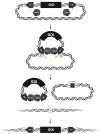Contemporary Transposon Tools: A Review and Guide through Mechanisms and Applications of Sleeping Beauty, piggyBac and Tol2 for Genome Engineering
- PMID: 34064900
- PMCID: PMC8151067
- DOI: 10.3390/ijms22105084
Contemporary Transposon Tools: A Review and Guide through Mechanisms and Applications of Sleeping Beauty, piggyBac and Tol2 for Genome Engineering
Abstract
Transposons are mobile genetic elements evolved to execute highly efficient integration of their genes into the genomes of their host cells. These natural DNA transfer vehicles have been harnessed as experimental tools for stably introducing a wide variety of foreign DNA sequences, including selectable marker genes, reporters, shRNA expression cassettes, mutagenic gene trap cassettes, and therapeutic gene constructs into the genomes of target cells in a regulated and highly efficient manner. Given that transposon components are typically supplied as naked nucleic acids (DNA and RNA) or recombinant protein, their use is simple, safe, and economically competitive. Thus, transposons enable several avenues for genome manipulations in vertebrates, including transgenesis for the generation of transgenic cells in tissue culture comprising the generation of pluripotent stem cells, the production of germline-transgenic animals for basic and applied research, forward genetic screens for functional gene annotation in model species and therapy of genetic disorders in humans. This review describes the molecular mechanisms involved in transposition reactions of the three most widely used transposon systems currently available (Sleeping Beauty, piggyBac, and Tol2), and discusses the various parameters and considerations pertinent to their experimental use, highlighting the state-of-the-art in transposon technology in diverse genetic applications.
Keywords: gene therapy; genetic screens; genome engineering; induced pluripotent stem cells; nonviral; transgenesis; transposition; transposon.
Conflict of interest statement
Z.I. is an inventor on patents relating to
Figures



Similar articles
-
The Sleeping Beauty transposon toolbox.Methods Mol Biol. 2012;859:229-40. doi: 10.1007/978-1-61779-603-6_13. Methods Mol Biol. 2012. PMID: 22367875 Review.
-
Sleeping beauty transposition: biology and applications for molecular therapy.Mol Ther. 2004 Feb;9(2):147-56. doi: 10.1016/j.ymthe.2003.11.009. Mol Ther. 2004. PMID: 14759798 Review.
-
The expanding universe of transposon technologies for gene and cell engineering.Mob DNA. 2010 Dec 7;1(1):25. doi: 10.1186/1759-8753-1-25. Mob DNA. 2010. PMID: 21138556 Free PMC article.
-
Genome-wide target profiling of piggyBac and Tol2 in HEK 293: pros and cons for gene discovery and gene therapy.BMC Biotechnol. 2011 Mar 30;11:28. doi: 10.1186/1472-6750-11-28. BMC Biotechnol. 2011. PMID: 21447194 Free PMC article.
-
Latest Advances for the Sleeping Beauty Transposon System: 23 Years of Insomnia but Prettier than Ever: Refinement and Recent Innovations of the Sleeping Beauty Transposon System Enabling Novel, Nonviral Genetic Engineering Applications.Bioessays. 2020 Nov;42(11):e2000136. doi: 10.1002/bies.202000136. Epub 2020 Sep 16. Bioessays. 2020. PMID: 32939778
Cited by
-
Advancements in mammalian display technology for therapeutic antibody development and beyond: current landscape, challenges, and future prospects.Front Immunol. 2024 Sep 24;15:1469329. doi: 10.3389/fimmu.2024.1469329. eCollection 2024. Front Immunol. 2024. PMID: 39381002 Free PMC article. Review.
-
Urine-derived stem cells serve as a robust platform for generating native or engineered extracellular vesicles.Stem Cell Res Ther. 2024 Sep 11;15(1):288. doi: 10.1186/s13287-024-03903-0. Stem Cell Res Ther. 2024. PMID: 39256816 Free PMC article.
-
Engineering strategies to safely drive CAR T-cells into the future.Front Immunol. 2024 Jun 19;15:1411393. doi: 10.3389/fimmu.2024.1411393. eCollection 2024. Front Immunol. 2024. PMID: 38962002 Free PMC article. Review.
-
Functional Characterization of the N-Terminal Disordered Region of the piggyBac Transposase.Int J Mol Sci. 2022 Sep 7;23(18):10317. doi: 10.3390/ijms231810317. Int J Mol Sci. 2022. PMID: 36142241 Free PMC article.
-
Engineering Closed-Loop, Autoregulatory Gene Circuits for Osteoarthritis Cell-Based Therapies.Curr Rheumatol Rep. 2022 Apr;24(4):96-110. doi: 10.1007/s11926-022-01061-x. Epub 2022 Apr 11. Curr Rheumatol Rep. 2022. PMID: 35404006 Review.
References
-
- Kulkosky J., Jones K.S., Katz R.A., Mack J.P., Skalka A.M. Residues critical for retroviral integrative recombination in a region that is highly conserved among retroviral/retrotransposon integrases and bacterial insertion sequence transposases. Mol. Cell. Biol. 1992;12:2331–2338. doi: 10.1128/MCB.12.5.2331. - DOI - PMC - PubMed
-
- Bujacz G., Alexandratos J., Wlodawer A., Merkel G., Andrake M., Katz R.A., Skalka A.M. Binding of different divalent cations to the active site of avian sarcoma virus integrase and their effects on enzymatic activity. J. Biol. Chem. 1997;272:18161–18168. doi: 10.1074/jbc.272.29.18161. - DOI - PubMed
Publication types
MeSH terms
Substances
LinkOut - more resources
Full Text Sources
Other Literature Sources

